Research Laboratory of Electronics
The Research Laboratory of Electronics (RLE), founded in 1946, is the Institute's first interdisciplinary research laboratory. Today it is the largest such laboratory at MIT in terms of faculty and student participation. RLE grew out of the wartime MIT Radiation Laboratory and was formed to bring together physicists and electrical engineers to work on problems in electromagnetic radiation, circuits, and specialized vacuum tubes. Over the years, RLE's research interests have branched in many directions and have led to the creation of additional laboratories.
 |
Research within RLE today is conducted by approximately 40 faculty members who are affiliated with the Departments of Electrical Engineering and Computer Science, Physics, Mechanical Engineering, Materials Science and Engineering, Aeronautics and Astronautics, and the Harvard-MIT Division of Health Sciences and Technology. During the past year, approximately 250 graduate students and 60 undergraduates from 11 MIT Departments pursued research within RLE. The research is supported primarily by: the Department of Defense (DoD) agencies; the Department of Energy (DOE); the National Science Foundation (NSF); the National Institutes of Health (NIH); and the National Aeronautics and Space Administration (NASA). In addition, numerous projects are funded through industry and private foundations.
RLE research is widely varied and consists of four major inter-related groupings: circuits, systems, and communications; physical sciences; quantum computation and communication; photonic materials, devices, and systems; and communication biophysics. Detailed information about RLE research in the calendar year 2001 can be found in the RLE Progress Report No. 144. The report is online at http://www.rle.mit.edu/Publications/prog.htm/.We summarize research highlights during the past year.
Circuits, Systems, and Communications
Professor Jacob White has completed development of FastStokes, a fast 3D Stokes solver useful for computing drag forces in viscous flows. The program was used to compute drag forces on a complicated micromachined comb drive and a micromirror. It is the only simulation program fast enough to analyze such complicated three dimensional structures in a reasonable period of time, and so was the only approach able to accurately predict the amplitude of the comb drive and micromirror response at resonance, as verified by measurements.
Professor Alan Oppenheim has developed several new and innovative algorithms relating to efficient ways of implementing signal processing. Particular examples include his work on distributed signal processing, and the completion of a new, general approach known as quantum signal processing. Professor Oppenheim has also developed some new algorithms associated with randomized sampling strategies and with nonuniform sampling.
Professor Gregory Wornell directs the newly formed Center for Wireless Networking. His research focuses on algorithmic and architectural aspects of the design of multimedia content security systems, wireless communication and sensor networks, and reliable circuits and microsystems. During the past year, he has developed the fundamental limits and inherent tradeoffs for multimedia authentication, and the structure of robust digital signature systems that achieve these limits. In the area of wireless networks, he has developed a promising new system-level architecture for wireless local area networks that can support gigabit per second data rates in typical environments by exploiting advanced coding and signal processing algorithms in a multiple-antenna access point design.
Professor Jae Lim's Advanced Telecommunications and Signal Processing (ATSP) group participated in the design of the Grand Alliance digital High-Definition Television (HDTV) system, which served as the basis for the U.S. digital television standard adopted by the Federal Communications Commission. During the past year, Professor Lim has sought ways to migrate to a higher resolution digital television system using video enhancement bits. Preliminary results have been encouraging, and one of the approaches developed by the ATSP group has to potential to serve as the basis for a future standard.
Professor David Staelin and Dr. Philip Rosenkranz have continued their work on the development of instruments and algorithms for retrieving atmospheric and surface parameters from data collected by airborne or satellite sensors. They are members of the science team that is studying microwave and hyperspectral imagery of the atmosphere using data from the NASA's recently launched Aqua satellite. Also, during the past year, they have completed construction and flight testing on high-altitude aircraft of a 183-GHz 6-channel imaging spectrometer that complements the existing RLE 54- and 118-GHz imaging spectrometer aircraft instruments, which support NOAA and NASA in remote sensing of weather systems. In addition, Professor Staelin made significant improvements to algorithms that use these microwave satellite assets to image quantitatively the global rain rates and snowfall, offering a potentially important new tool for operational monitoring of the global water balance.
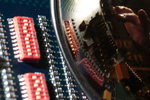 |
Professor Rahul Sarpeshkar is pursuing a collection of projects in biologically inspired electronics. His low power bionic ear project involves designing an ultra low power analog cochlear implant processor whose performance will exceed that of digital processors by more than an order of magnitude. During the past year, Professor Sarpeshkar completed work on the ultra low power programmable bandpass filter for use in the bionic ear. In his project on time-based hybrid computing, Professor Sarpeshkar is combining the best of analog and digital architectures to compute more efficiently than would be possible in either paradigm alone.
Professor John Wyatt is working on a retinal implant device to restore some level of useful vision to patients with outer retinal diseases. During the past year he has designed a low power stimulation circuit for use in this implant. He has also microfabricated a new retinal attachment device. Both of these results may be of use in more general neural implant devices.
Professor Donald Troxel is working on the design of three-dimensional integrated circuits (3D ICs). In particular, he has developed a comprehensive layout methodology for bonded 3D ICs, in which parts of a circuit are fabricated on different wafers, and then the wafers are bonded with a glue layer of Cu or polymer-based adhesive. Using his methodology, designers can, for the first time, layout such 3D circuits with necessary information on inter-wafer via/contact and the orientation of each wafer embedded in the layout.
Professor Dennis Freeman has developed an optical projector that coherently combines light from a discrete set of laser beams to produce a "needle" of light, i.e., a light pattern that has high spatial resolution in the lateral direction and large axial depth of field. In other structured illumination work, Professor Freeman has demonstrated resolution-enhanced microscopy, by reconstructing an image of a constellation of microparticles that could not be resolved with uniform illumination.
Physical Sciences
Professors Daniel Kleppner and Thomas Greytak are continuing their studies of ultracold hydrogen. During the past year, they completed an experimental study of the growth dynamics of a Bose-Einstein condensate of hydrogen, and found good agreement with a recent theoretical analysis. They also studied collisions between ultracold metastable hydrogen atoms, and obtained the first observations of the collision rate between these atoms. The results were in reasonable agreement with new, and somewhat surprising, theoretical predictions. Work was undertaken on the trapping of ultracold deuterium, and a new program on ultraprecise spectroscopy of hydrogen was initiated.
Professor David Pritchard has demonstrated a new type of matter-wave interferometer, called the contrast interferometer, that is insensitive to many of the systematic effects that have plagued other atom interferometry experiments. It works by encoding the desired signal in the contrast of the interference pattern, while leaving much of the noise in the phase of the interference pattern, which is not measured. In his experiment, the photon-recoil frequency of sodium was measured with a statistical error of 15 parts per million. The recoil frequency is due to the kinetic energy imprinted on an atom by the scattering of a single photon. Precision measurements of this frequency can be combined with other recent measurements to give a new independent route to the determination of the fine-structure constant.
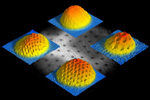 |
Professor Wolfgang Ketterle's research concentrates on the properties of Bose-Einstein condensates and Fermi seas. Such quantum degenerate gases are novel systems in which to study many body physics, including phase transitions, superfluidity, and vortices. During the past year, he has extended experimental methods of laser and evaporative cooling to realize quantum degeneracy in trapped Fermi gases, thus providing a rich, new system to explore the implications of Pauli exclusion on scattering properties and, ultimately, fermionic superfluidity. Professor Ketterle has also made substantial progress in coherent manipulation of matter-wave sources. In particular, he has demonstrated that a gaseous Bose-Einstein condensate can be transported with optical tweezers and then transferred into a magnetic trap that was microfabricated on a silicon substrate. Finally, he was the first produce a continuous source of Bose-Einstein condensed atoms, by periodically replenishing a condensate held in an optical dipole trap with new condensates thereby continuously maintaining a condensate of more than 106 atoms.
Professor John Joannopoulos has been working on an ab-initio exploration of the energetics of bistability in Si dimers on the Si (100) surface and their potential use as elements to form logic gates. Device miniaturization—the focus of modern seminconductor-based computer technology—is approaching its downscaling limit, and alternative paradigms employing nano-scale components are being sought. Professor Joannopoulos's research is aimed at systems that self-assemble into logic gates. His calculations predict that a Tungsten scanning probe can mediate the interactions between bistable Si (100) surface dimers. Interpreting the state of each dimer as a bit of information, his calculations then demonstrated the use of this mediated interaction to construct a NOR logic gate.
Professor Abraham Bers made significant progress in three areas of plasma electrodynamics. He has used general properties of wave energy-flow conservation and time reversibility to derive symmetry properties of linear mode conversion. Simulated Raman scattering (SRS) that induces Langmuir decay interactions (LDI) was explored in both theoretical and experimental work. Finally, in collaboration with Dr. Yves Peysson of the Commissariat à l'Énergie Atomique, Professor Bers developed an improved code for studying the self-consistent generation of RF current drive and bootstrap current, currents of importance for steady-state tokomak operation.
Professor Bruno Coppi continued to make progress in his investigations of the physics of high energy plasmas. His work addressed a broad spectrum of subjects related to the large class of plasmas dominated by collective modes rather than by collisional processes. These efforts included work in the basic physics of fusion burning plasmas, the design of fusion burning experiments, advances in computational physics and theory related to the excitation of macroscopic modes in magnetically-confined plasmas, and the determination of modes than can provide the outward transport of angular momentum in accretion disks.
Dr. Linda Sugiyama is continuing her development of a large-scale simulation code for magnetically confined plasmas. The major achievement of the past year was the full implementation of a two fluid plasma model (electron and ion fluids) in the formerly single-fluid code M3D. M3D runs on massively parallel machines, and can handle most varieties of confined plasma configurations. The new code was used to study magnetic reconnection in different plasma configurations.
Professor Jin Kong's research on electromagnetics has concentrated on three essential activities: left handed media, unexploded ordnance (UXO) detection, and remote sensing of vegetation. His work on left handed media includes both theory and numerical simulations related to media exhibiting a negative index of refraction. In UXO detection studies, he has initiated a combined approach using finite elements and integral equations. In vegetation sensing, he has carried out polarimetric studies of forests in Japan, in order to estimate forest density from synthetic aperture radar (SAR) imagery.
Quantum Computation and Communication
Professor Seth Lloyd works on building and operating quantum computers and quantum communication systems. Major accomplishments during the past year include: development of a new quantum computer architecture using ground state quantum computation; a theoretical demonstration that quantum effects such as entanglement could be used to enhance the accuracy of positioning, radar, and clock synchronization systems; and the first quantum computations showing quantum chaos on a quantum computer. In addition, Professor Lloyd has shown how quantum information processing could provide a significant increase in the capacity of power limited quantum communication channels.
Professor Jeffrey Shapiro and Dr. Franco Wong have been working on the generation of entangled photons and their applications in quantum communications and quantum cryptography. During the past year, they demonstrated high flux sources of wavelength-tunable entangled photons generated by optical parametric downconversion in periodically poled nonlinear crystals. They also extended previous theoretical work on intracavity entanglement generation, revealing the existence of coincidence dips and revivals. In work on quantum communication architecture, they developed error models for the long distance teleportation architecture, whose technology elements are being developed at MIT and Northwestern University, and have shown how quantum error correction and/or entanglement purification protocols can improve the performance of this architecture. In classical-domain optical communications they have established a test bed for through the air laser communications, and have developed theoretical results for spatial diversity reception, space-time coding, and channel capacity for the turbulent atmospheric channel.
Professor Terry Orlando is using superconducting circuits as components for quantum computing and as model systems for nonlinear dynamics. The goal of the present research is to use superconducting quantum circuits to perform the measurement process, to model the sources of decoherence, and to develop scalable algorithms. The particular device being studied is made from a loop of niobium interrupted by 3-nm-size Josephson junctions. Professor Orlando has successfully demonstrated that the niobium qubit has low enough dissipation to behave quantum mechanically.
Dr. Selim Shahriar has, for the first time, demonstrated the slowing and eventual stopping of light in a solid. This has many potential applications, including teleportation of the quantum state of a macroscopic crystal. He has also designed, and demonstrated the feasibility of, a super-parallel holographic optical correlator that is capable of searching through 1 terabyte of data, encoded in 10 million images, in 1 msec. This correlator may find commercial applications in face recognition, fingerprint identification, and video data mining.
Photonic Materials, Devices, and Systems
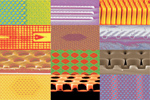 |
Professor Leslie Kolodziejski and Dr. Gale Petrich are working on the fabrication of opto-electronic devices composed of III-V compound semiconductors. Their principal research activities for the past year include: development of a feedback system for the controlled deposition of III-V epilayers using a molecular beam epitaxy (MBE) system in conjunction with a spectroscopic ellipsometer; the development of InP-based and GaAs-based bipolar cascade lasers; the development of a variety of high index contrast, photonic crystal devices; and the use of electro-mechanical motion to modify optical device behavior. A particular achievement of note was the significant improvement in the extraction efficiency of photo-pumped light emitting diodes by inclusion of a photonic crystal within the active region.
Professor Henry Smith directs the NanosStructures Laboratory
(NSL), whose dual mission is the development of advanced
nanofabrication technology and the application of that technology to
research in optical, electronic, and magnetic devices. Research
highlights from the past year include the demonstration of 17-nm
minimum linewidths in a new scanning-electron-beam lithography system
that, together with nanometer-level placement accuracy, is a major step
forward in MIT's unique capabilities in nanotechnology. Another
significant achievement, done in collaboration with Professor Moungi
Bawendi, was a distributed-feedback laser based on nanoparticles that
used gratings fabricated via interference lithography. Professor Smith
has invented a new way to fabricate 3D photonic crystals, and is
seeking a patent on this approach. This technique could enable the
promise of photonic bandgap structures to be finally realized in a
practical configuration.
Professor Yoel Fink has completed the construction of a state of the art fiber-optic fabrication facility. With this facility, he has unique infrastructure—from glass synthesis, through fiber draw tower, to optical characterization—for the development of photonic bandgap optical fibers. He has fabricated the world's first high index contrast cylindrical photonic bandgap fibers in two different configurations. The first uses dielectric layers on the outer circumference to form a highly reflective, "perfect mirror" fiber. The second has its dielectric layers surrounding a hollow core to provide a guiding structure for optical or quantum communications, called "Omniguide" fiber. Optical characterization has shown that the mirror fiber has reflectivity comparable to that of the best metal reflectors. CO2 laser transmission measurements through extended lengths of Omniguide fiber have shown low loss.
Professor Erich Ippen continues to develop the technology of ultrashort-pulse (femtosecond) lasers and to use these new sources in scientific and engineering applications. During the past year, he demonstrated quantum-limited timing jitter in high-repetition-rate picosecond pulse trains from both a fiber soliton laser and a modelocked semiconductor laser, confirming theoretical work done in collaboration with Professor Hermann Haus. Together with Professor Franz Kärtner, Professor Ippen has obtained the shortest pulses ever, less than 20 fs in duration, from a Cr4+:YAG laser. This laser employed photonic bandgap mirrors, for self-starting operation, grown by Professor Kolodziejski's group.
Professor Franz Kärtner is developing few-cycle laser sources for use in fundamental studies in nonlinear optics, frequency metrology, and optical imaging. In cooperation with Professor Wegener of the University of Karlsruhe, he has discovered carrier-wave Rabi-flopping in GaAs and extreme nonlinear optics in solids. He has also demonstrated a nonlinear Fabry-Perot resonator as an intracavity modulator for active laser modelocking and synchronization, and, together with Professor James Fujimoto, has developed a record bandwidth, prismless Ti:Sapphire laser and a low threshold Ti:Sapphire laser. The prismless Ti:Sapphire source has applications both in frequency metrology and high resolution optical coherence tomography. The low threshold Ti:Sapphire laser may lead to a femtosecond laser whose cost is a third of that of currently available technology.
Professor James Fujimoto divides his research efforts between two areas: laser medicine and diagnostics; and ultrashort-pulse laser technology. He continues to pioneer optical coherence tomography (OCT), a field which was created by his group in 1990. OCT is an emerging medical imaging technology that is analogous to ultrasound. In recent work, Professor Fujimoto has improved the image resolution of OCT from 10-15 µm to approximately 1 µm, and performed the first studies of ultrahigh resolution imaging in ophthalmology. Clinical imaging studies are now beginning in collaboration with investigators from the New England Eye Center. In addition to his work on new ultrashort-pulse lasers, cited above, Professor Fujimoto has begun studies of photonic device fabrication using ultrashort pulses. He has demonstrated the fabrication of single mode waveguides in glass as well as couplers and Mach-Zehnder interferometers. These techniques permit 3D waveguide structures to be fabricated, increasing the density of fabrication compared to planar structures.
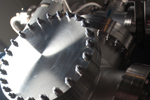 |
Professor Vladimir Bulovic studies the physical properties of organic thin films, structures and devices. During the past year, he developed a hybrid organic/inorganic heterostructured light emitting device that utilizes a single monolayer of self-assembled CdSe quantum dots as emissive centers. These devices surpass the efficiency of earlier quantum dot light-emitting diodes (LEDs) by a factor of 25 and, for the first time, demonstrate that quantum-dot-LED technology can reach the efficiencies necessary for commercial applications. In other work, Professor Bulovic developed a theoretical framework to explain the solid-state solvation effect that can produce energy level shifts in most organic materials, tuning the bandgap energy by as much as 0.3 eV.
Professor Rajeev Ram addresses the science questions that arise during the development of new opto-electronic devices, as well as issues of electron hydrodynamics, quantum transport, and micromagnetics. Research recent highlights include the development of two new semiconductor lasers that incorporate novel electron transport: bipolar cascade lasers and internally cooled semiconductor lasers. Bipolar cascade lasers utilize Esaki junctions to couple multiple active layers, leading to significantly higher differential efficiency and signal-to-noise ratio than for conventional semiconductor lasers. Work on internally cooled lasers has led to the development of the first theory for thermoelectric effects in bipolar devices under forward bias.
Professor Qing Hu's research is focused on the development of terahertz sources, detectors, and systems. During the past year, he has observed very narrow linewidth (approximately 0.7 meV) intersubband emission at 5 THz, and established coherent coupling between subband levels using magneto-tunneling spectroscopy. He has also designed an optically pumped intersubband THz laser structure, and a high-frequency HBT that uses phonon enhanced base transport.
Professor Peter Hagelstein has measured high efficiency for the conversion of thermal to electrical energy in a novel device that he has termed the "thermal diode." The basic structure consists primarily of a slab of near intrinsic thermoelectric semiconductor, with a thin moderately-doped emitter layer on the hot side. This layer injects a current into the semiconductor thermoelectric in the presence of a temperature gradient, greatly enhancing the conversion efficiency. This effect, which appears to be new, is attributed to a second-order thermionic effect. Experiments carried out at Eneco have yielded conversion efficiencies on the order of 40 percent of the Carnot limit for an n-type segment.
Communication Biophysics
Professor Kenneth Stevens is developing a set of principles that govern the variability observed in the acoustic patterns for words in continuous speech. Knowledge of these principles is leading to the formulation of models for the process by which human listeners identify words in running speech in spite of this variability. He is also engaged in basic studies of the aerodynamic, mechanical, acoustic, and perceptual processes involved in the generation of speech.
Dr. Stefanie Shattuck-Hufnagel studies the prosody of spoken language, both in the sense of the abstract structures that specify the prosody of a spoken utterance—e.g., intonational—in the sense of how those structures are reflected in the phonetic variation of word forms across different utterances. She has recently begun a new line of research, testing the hypothesis that speakers coordinate the gestures they make during speech with the prosodic structure of their utterances, e.g., by timing the end points of gestures to co-occur with pitch accented syllables.
Professor Louis Braida and Dr. Julie Greenberg are trying to predict the intelligibility of cochlear implant processed speech and to develop a subject-independent metric that can be used to predict the maximum possible intelligibility performance for particular cochlear implant speech processing strategies. During the past year, they have completed detailed analyses of several proposed metrics from the literature and begun to perform speech intelligibility experiments with human subjects.
Dr. Andrew Oxenham is addressing fundamental questions in pitch perception. Using stimuli that transpose information normally available at low frequencies into high frequency regions, he has discovered that the auditory system cannot use timing information alone to accurately extract pitch. This may be the first evidence that veridical place information is necessary for pitch perception. The results have important implications for models of auditory processing, as many modern models discard the place information at an early stage.
Professor Dennis Freeman made further advances in his work investigating cochlear mechanics to understand how inner ear mechanisms determine the neural code that relates sounds to nerve messages that enter the brain. During the past year, he has taken three dimensional images of the tectorial membrane as a function of time to measure tectorial membrane volume in fluids with various polyethylene glycol concentrations. In addition, an in vitro preparation for studying cochlear micromechanics was developed. By using stroboscopic illumination and the optical sectioning property of a light microscope, slow motion, three dimensional images of micromechanical structures during sound stimulation were obtained.
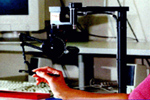 |
Dr. Mandayam Srinivasan directs the Touch Lab, whose research focus is haptics, viz., information acquisition and object manipulation through touch by humans and/or machines in real, virtual, or teleoperated environments. During the past year, he has made significant progress in studies of the biomechanics of skin, the development of virtual reality based surgical simulators, the development of a multi-user shared virtual environment with graphics and haptics (in collaboration with Professor Mel Slater of University College, London), and brain-machine interfaces (in collaboration with Professor Miguel Nicolelis of Duke University). In his "Touch Across the Atlantic" project, individual users at University College, London and MIT were able to manipulate virtual objects in real time in a collaborative manner, while simultaneously seeing the objects on their monitors and feeling each other's forces on the tool held in their hand.
Dr. Joseph Perkell has launched a four year project to study the effects of hearing status on adult speech production. Together with his collaborators from the University of Miami, he has been gathering large amounts of acoustic and perceptual data from patients both prior to and following the introduction of hearing with a cochlear implant. Preliminary results support the hypothesis that hearing enhances a speaker's ability to adapt to perturbations that are introduced to the vocal tract. In the long run, these studies could have applications to methods for diagnosing and treating communication disorders.
Dr. Bertrand Delgutte has been working to understand the relative perceptual importance of the slowly varying temporal envelope of sounds versus their rapidly varying fine time structure. Together with Dr. Oxenham, he has created novel chimeric sounds that combine the temporal envelope of one sound with the fine structure of another. Experiments with these sounds have shown that speech reception depends primarily on the envelope, whereas melody recognition and sound localization rely on the fine structure. This finding suggests that modifying cochlear implants processors to deliver fine structure information would improve music appreciation, and, for patients implanted in both ears, speech reception in noise.
Dr. Donald Eddington's research is directed at a number of issues related to cochlear implants. Based on last year's work, which demonstrated that electrode interaction adversely affects speech recognition, Dr. Eddington developed and tested a novel stimulus waveform to reduce this interaction by as much as 80 percent. He then designed sound-processing strategies that employed this waveform and found that some patients improved their scores on consonant or vowel reception tests by 25 percent when the new strategies were used.
Dr. George Zweig continued his work to creating novel adaptive transforms of acoustic signals that qualitatively improve the identification of sounds in noisy environments. Such transforms can be implemented in low power analog VLSI circuitry for sound preprocessing in microelectromechanical systems (MEMS). During the past year, Dr. Zweig established the connection between transforms based on convolutions, like the waveform of the cochlea, and solutions of certain partial differential equations. Methods for inverting those transforms were developed, so that those transforms, when thresholded, can be used to remove noise from sounds.
Appointments and Awards
Professor Jacob K. White was appointed associate director. Joseph C.
Connolly's title was changed to assistant director for
administration. William H. Smith, III was promoted to assistant
director for finance and sponsor relations. David W. Foss's title
was changed to manager of information systems and networking. Mary E.
Young was promoted to senior fiscal officer. Rosaria M. Rizzo was
promoted to fiscal officer. Maureen C. Howard was promoted to personnel
staff assistant. Maxine P. Samuels was promoted to financial staff
assistant (Purchasing). Lorraine J. Simmons was promoted to financial
staff assistant (Accounting). Krista Van Guilder was appointed to the
position of media specialist. Professor Franz X. Kärtner was
appointed associate professor of electrical engineering and computer
science with permanent tenure. Dr. Yoel Fink was appointed assistant
professor of materials science and engineering. Marc Baldo was
appointed assistant professor of electrical engineering and computer
science. Professor David E. Pritchard was appointed the Cecil and Ida
Green professor of physics. Professor Qing Hu was promoted to full
professor, effective 1 July 2002. Professor Seth Lloyd was promoted to
full professor, effective 1 July 2002. Professor Gregory W. Wornell was
promoted to full professor, effective 1 July 2002. Professor Dennis M.
Freeman received permanent tenure, effective 1 July 2002.
Professor Wolfgang Ketterle shared the 2001 Nobel Prize in Physics.
Professor Daniel Kleppner was selected by the National Academy of
Sciences to give the 2002 Robertson Memorial Lecture. Professor James
G. Fujimoto was elected a Fellow of the American Academy of Arts and
Sciences, and shared the 2002 Rank Prize for Opto-Electronics.
Professor Rajeev Ram received the Ruth and Joel Spira Award for
Excellence in Teaching. Professor Rahul Sarpeshkar received a David and
Lucille Packard Foundation Fellowship and an Office of Naval Research
(ONR) Young Investigator Award. Dr. Andrew Oxenham was awarded the R.
Bruce Lindsay Award by the Acoustical Society of America. William H.
Smith, III, Albert T. McGurl, and Carol A. Costa received 2002
MIT Infinite Miles Awards.
Affirmative Action
RLE has worked and will continue working to increase the number of women and minorities in career positions in the laboratory, in the context of the limited pool of qualified technical applicants and the unique qualifications of RLE's sponsored research staff. Specific measures will include: maintaining our high standards for recruitment procedures that include sending job postings to minority colleges and organizations; working closely with the RLE faculty/staff supervisor at the beginning of each search to identify ways of recruiting minority and women candidates for the new position; and being committed to finding new techniques to identify more effectively women and minority candidates. During the past year significant progress has been made, in this regard, within RLE Headquarters. In particular, two women on RLE's administrative staff received promotions; three women (two of them underrepresented minorities) were promoted from support staff to administrative staff positions; and a woman was appointed to the newly created position of media specialist. However, due to limited turnover in RLE's research staff, success in affirmative action for research staff has been limited. Two research staff appointments were made during the past year; both were to women.
More information about the Research Laboratory of Electronics can be found at http://www.rle.mit.edu/.